9 Best Climbing in Nepal
Nepal is filled with adventure in every nook and corner. The type of adventurous sport can be found from land to air to water. By far the most adventurous sport that Nepal has to offer is definitely climbing a peak in the Himalayas. Climbing isn’t just about reaching the summit, it requires days and days of preparations. You would be challenged widely physically and mentally. You can experience the hilly trekking trails, cultural and religious differences from lower to upper elections, diverse flora and fauna of which many are conserved in the restricted and conserved areas of Nepal, and many more. This collective experience can be summed up as climbing.
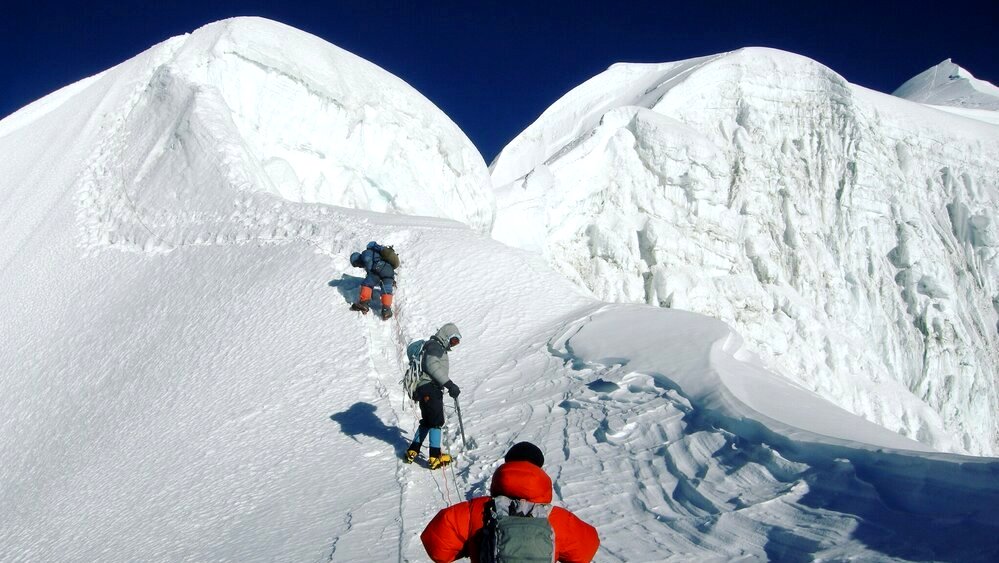
Nepal is naturally gifted with some amazing geographical structures, beautiful landscapes, plain lands, and mighty mountains. These sights are covered during your one climbing expedition. Though more than 1310 peaks are counted in Nepa only 326 peaks are permitted for the expedition. These peaks range anywhere from 5000m and above to the tallest peak in the world “8848.86m”. Even if you are just a beginner at climbing Nepal will not let you go freehand, it has always something to offer you. You can choose a peak based on the number of experiences you previously have with trekking and climbing, your current physical and mental status, and your potential plan to climb a summit of which elevation. These all take quite a research and development, which is why before making a plan to climb a peak you are highly suggested to start before one year of the expedition that could be the least preparation time for you as climbing a peak of that elevation isn’t a joke either.
Everest (8,848.86m)
Mount Everest, revered as "Chomolungma" by the Sherpas, reigns as the world's apex, with its staggering height of 8,848.86 meters (29,031.7 feet) amidst the Himalayas. For mountaineers, it's not just a peak—it's an emblem of ambition and the ultimate testament to adventure. The duo of Sir Edmund Hillary from New Zealand and Tenzing Norgay Sherpa from Nepal first planted their flags atop its summit on June 3, 1953, inscribing an unparalleled chapter in the annals of mountaineering. Everest, ever since, stands as a symbol of human tenacity, perseverance, and the spirit of exploration.
The journey to Everest's pinnacle isn't for the faint of heart. It demands rigorous physical preparation, meticulous acclimatization to biting altitudes, and braving the unpredictable moods of Mother Nature. An expedition can span approximately 60 days, swayed by weather, route nuances, and the climber's altitude acumen.
 climbing.jpg)
But those who endure are rewarded with more than just a view; it's a horizon of endless peaks and a moment frozen in time, encapsulating the sheer grit and passion that carried them to the top of the world. At Everest's zenith, one doesn't just stand atop a mountain, but atop their dreams, ambitions, and the very essence of adventure.
Important Tips for the Mount Everest Expedition
Here are some important tips to consider when you are planning for the Mount Everest Expedition
- Physical Fitness: Prioritize your physical fitness and endurance. Engage in regular cardiovascular exercises, strength training, and endurance-building activities. Consult with a fitness professional to develop a customized training plan.
- Acclimatization: Adequate acclimatization is crucial to prevent altitude sickness. Plan a gradual ascent with sufficient rest days at various elevations to allow your body to adjust to the altitude.
- Climbing Experience: Gain significant climbing experience on smaller peaks before attempting Everest. Familiarize yourself with the technical skills required for mountaineering, such as ice climbing, rope handling, and crevasse rescue.
- Professional Guidance: Seek the assistance of experienced mountaineering guides. They can provide invaluable guidance, support, and expertise throughout the climb.
- Safety Equipment: Invest in high-quality mountaineering gear and equipment, including proper clothing, boots, gloves, goggles, helmets, and climbing tools. Carry essential safety equipment like ropes, harnesses, carabiners, and avalanche gear.
- Altitude Medication: Consult with a healthcare professional who specializes in high-altitude medicine. They can provide appropriate medications like Diamox to prevent altitude sickness. Follow their guidance on dosage and usage.
- Nutrition and Hydration: Maintain a well-balanced diet that includes high-calorie and nutrient-rich foods to fuel your body during the climb. Stay hydrated by drinking plenty of fluids, even when you don't feel thirsty.
- Teamwork: Everest climbing is a team effort. Foster good communication and teamwork skills with your fellow climbers and support staff. Look out for one another's safety and well-being.
- Weather Conditions: Keep a close eye on the weather conditions and forecasts. Avoid climbing during the monsoon season or when there are unfavorable conditions that could compromise safety.
- Mental Preparation: Climbing Everest is mentally demanding. Prepare yourself for the physical and psychological challenges you may face. Build mental resilience, be prepared for setbacks, and stay focused on your goals.
- Environmental Responsibility: Practice Leave No Trace principles and respect the mountain environment. Dispose of waste properly and adhere to local regulations to minimize your impact on the fragile ecosystem.
- Contingency Plans: Develop contingency plans for emergencies, including evacuation procedures and communication protocols. Familiarize yourself with emergency signals and procedures, and carry a satellite phone or communication device.
Remember, climbing Everest is an extremely challenging endeavor, and safety should always be the top priority. It's crucial to be well-prepared, physically and mentally, and to make informed decisions throughout the journey.
Lhotse (8,516m)
Mount Lhotse, standing at an elevation of 8,516 meters (27,940 feet), is the world's fourth-tallest mountain and is located in close proximity to Mount Everest, also known as Sagarmatha. The first successful ascent of Lhotse was achieved by a Swiss expedition team in 1956, adding to the rich history of mountaineering in Nepal.
One of the main attractions of climbing Lhotse is the breathtaking panoramic views from the summit. On a clear day, climbers can witness stunning vistas of Mount Everest, Mount Nuptse, Mount Cho-Oyu, Mount Ama Dablam, Mount Pumori, Island Peak, and Thamserku, among other peaks in the region. The awe-inspiring scenery from the top of Lhotse is a rewarding experience for mountaineers. The Lhotse has three subsidiaries Lhotse East, Lhotse Shar, and the peak itself Lhotse Main. The climb of Lhotse requires advanced technical skill as some of the terrains of Lhotse have steeped nearly 80 degrees. This requires using of different gears and you must prepare very hard in the preparation session. The peak is the steepest in the region with a rising slope at a very low elevation.
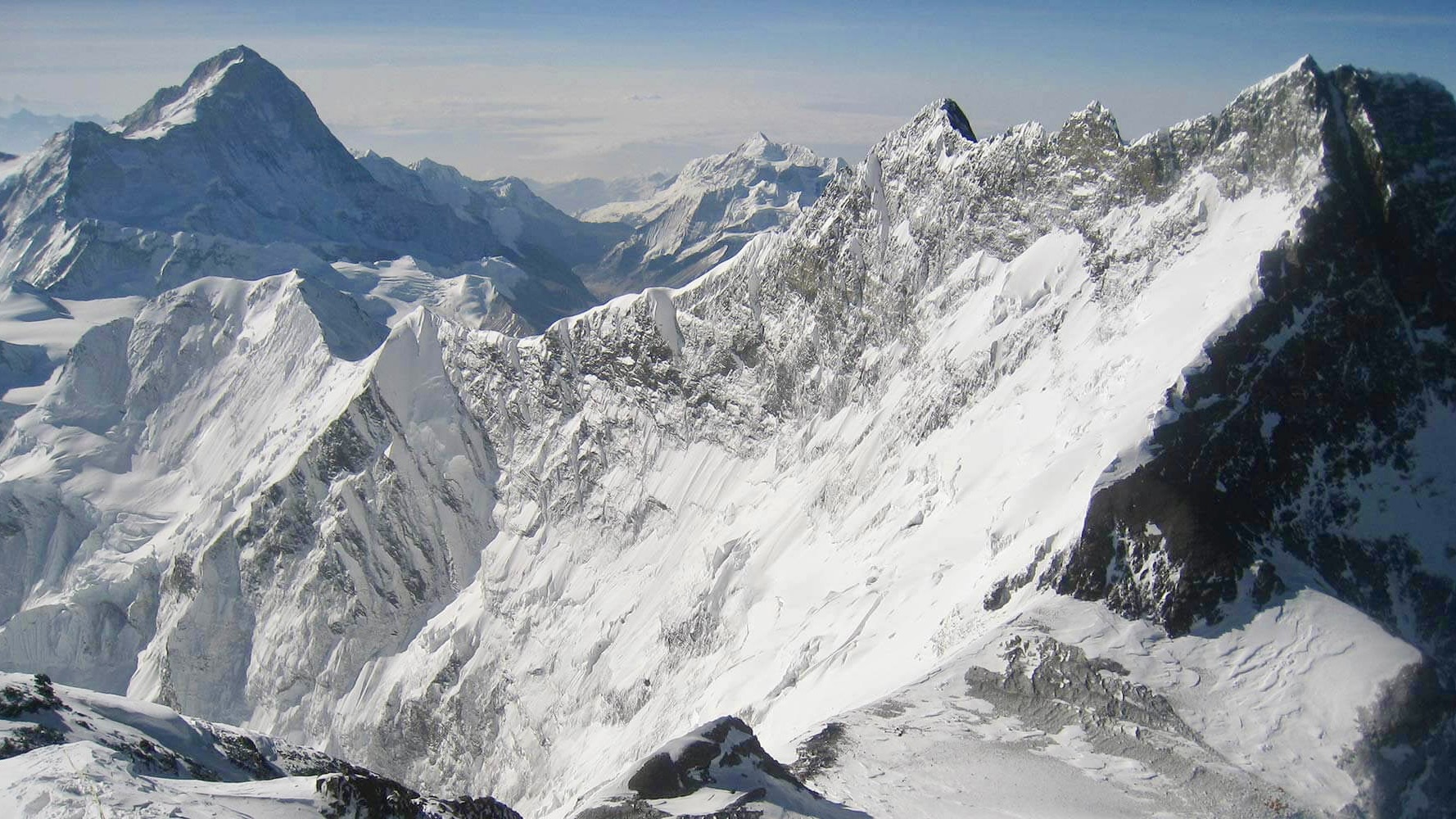
Important Tips for the Lhotse Expedition
Here are some important tips to consider when you are planning for the Lhotse Expedition:
- Physical Fitness: Focus on building your physical strength and endurance. Engage in a comprehensive training program that includes cardiovascular exercises, strength training, and endurance activities. Pay special attention to leg strength and aerobic fitness.
- Climbing Experience: Gain experience in high-altitude mountaineering before attempting Lhotse Peak. Familiarize yourself with technical skills like ice climbing, rock climbing, and glacier travel. Prior experience on other high peaks will help you prepare for the challenges of Lhotse.
- Acclimatization: Allow sufficient time for acclimatization to avoid altitude sickness. Plan a gradual ascent with rest days at different elevations to help your body adjust to the increasing altitude. Follow a well-designed acclimatization schedule.
- Guides and Support: Consider hiring experienced mountaineering guides that offer support services for Lhotse Peak. Their knowledge, experience, and logistical support can enhance your safety and chances of success.
- Safety Equipment: Invest in high-quality mountaineering gear suitable for climbing Lhotse Peak. This includes clothing, boots, gloves, helmets, crampons, ice axes, ropes, harnesses, and necessary safety gear. Make sure your equipment is in good condition and properly fitted.
- Altitude Medication: Consult with a healthcare professional who specializes in high-altitude medicine. They can provide advice on altitude medication like Diamox to help prevent and manage altitude sickness. Follow their guidance on dosage and usage.
- Nutrition and Hydration: Maintain a well-balanced diet that provides adequate energy and nutrition for the demanding climb. Consume calorie-dense foods and prioritize hydration by drinking plenty of fluids, even when you don't feel thirsty.
- Weather Conditions: Stay updated on weather conditions and forecasts specific to the Lhotse region. Be prepared for rapidly changing weather and plan your climb accordingly. Avoid climbing during extreme weather or unfavorable conditions that could compromise safety.
- Mental Preparation: Climbing Lhotse Peak requires mental resilience and determination. Prepare yourself mentally for the physical and psychological challenges you may face. Develop a positive mindset, manage stress effectively, and stay focused on your goals.
- Environmental Responsibility: Respect the mountain environment and practice responsible mountaineering. Follow Leave No Trace principles, minimize your impact on the ecosystem, and adhere to local regulations. Properly dispose of waste and avoid damaging the environment.
- Emergency Preparedness: Have contingency plans for emergencies and familiarize yourself with evacuation procedures. Carry a satellite phone or communication device for emergencies. Stay aware of your surroundings and be prepared to respond to unexpected situations.
Remember, climbing Lhotse Peak is a demanding and serious endeavor. Prioritize safety, seek proper training and guidance, and be well-prepared both physically and mentally. Enjoy the experience while respecting the mountain and fellow climbers.
Manasalu (8,163m)
Majestically rising to 8,163 meters, Manaslu secures its rank as the world's eighth-highest mountain. Nestled within the revered Annapurna circuit and safeguarded by the Manaslu Conservation Area, this peak has captivated the hearts of climbers since it was first conquered by a Japanese team in 1952. While several routes lead to Manaslu's zenith, its intricate terrains and advanced technical demands offer diverse paths of ascent, each with its own set of challenges and wonders. Despite its rigorous climb, Manaslu promises an experience akin to that of the world's loftiest summits, often with higher success rates.
Beyond its imposing stature, Manaslu's environs burst with biodiversity. As adventurers traverse its trails, they're greeted by a vibrant tapestry of ecosystems teeming with rare flora and fauna. The region not only beckons with the thrill of high-altitude climbing but also enchants with the raw beauty of untouched nature, making every expedition here an unforgettable odyssey.
 climbing.jpg)
Importance Tips for the Manaslu Expedition
Here are some important tips to consider when you are planning for the Manaslu Expedition
- Physical Fitness: Focus on building your overall physical fitness and endurance. Engage in a comprehensive training program that includes cardiovascular exercises, strength training, and endurance activities. Pay particular attention to developing leg strength and aerobic fitness.
- Climbing Experience: Gain experience in high-altitude mountaineering before attempting Mount Manaslu. Familiarize yourself with technical skills such as ice climbing, glacier travel, and rope handling. Prior experience on other high peaks will help you prepare for the challenges of Manaslu.
- Acclimatization: Allow sufficient time for acclimatization to prevent altitude sickness. Plan a gradual ascent with rest days at different elevations to help your body adjust to the increasing altitude. Follow a well-designed acclimatization schedule.
- Guides and Support: Consider hiring experienced mountaineering guides that offer support services for Mount Manaslu. Their knowledge, experience, and logistical support can enhance your safety and chances of success.
- Safety Equipment: Invest in high-quality mountaineering gear suitable for climbing Mount Manaslu. This includes clothing, boots, gloves, helmets, crampons, ice axes, ropes, harnesses, and necessary safety gear. Ensure that your equipment is in good condition and properly fitted.
- Altitude Medication: Consult with a healthcare professional who specializes in high-altitude medicine. They can provide advice on altitude medication like Diamox to help prevent and manage altitude sickness. Follow their guidance on dosage and usage.
- Nutrition and Hydration: Maintain a well-balanced diet that provides adequate energy and nutrition for the demanding climb. Consume calorie-dense foods and prioritize hydration by drinking plenty of fluids, even when you don't feel thirsty.
- Weather Conditions: Stay updated on weather conditions and forecasts specific to the Mount Manaslu region. Be prepared for rapidly changing weather and plan your climb accordingly. Avoid climbing during extreme weather or unfavorable conditions that could compromise safety.
- Mental Preparation: Climbing Mount Manaslu requires mental resilience and determination. Prepare yourself mentally for the physical and psychological challenges you may face. Develop a positive mindset, manage stress effectively, and stay focused on your goals.
- Environmental Responsibility: Respect the mountain environment and practice responsible mountaineering. Follow Leave No Trace principles, minimize your impact on the ecosystem, and adhere to local regulations. Properly dispose of waste and avoid damaging the environment.
- Emergency Preparedness: Have contingency plans for emergencies and familiarize yourself with evacuation procedures. Carry a satellite phone or communication device for emergency situations. Stay aware of your surroundings and be prepared to respond to unexpected situations.
Remember, climbing Mount Manaslu is a serious undertaking that requires careful planning, physical fitness, and mountaineering skills. Prioritize safety, seek proper training and guidance, and be well-prepared both physically and mentally. Enjoy the experience while respecting the mountain and fellow climbers.
Pumori Peak (7161m)
Situated in the breathtaking Khumbu region, Pumori soars to 7,161 meters, enchanting mountaineers with its imposing silhouette. Traditionally known as the “mountain daughter,” Pumori's name is as evocative as the vistas it offers. Its first successful ascent was credited to Gerhard Lenser of a German-Swiss expedition on May 17, 1962.
While residing in the shadows of its loftier neighbors, Pumori offers an experience reminiscent of scaling an eight-thousander. From its vantage points, climbers are graced with unparalleled views of iconic peaks like Lhotse and Everest. Yet, its pyramid-like structure is not just aesthetically unique but also presents technical challenges. This makes Pumori a pursuit best suited for seasoned climbers, demanding not just stamina but honed skills that often come from experience with similar altitude peaks. For those ready for its challenges, Pumori promises an unforgettable adventure crowned with some of the Himalayas' most awe-inspiring panoramas.
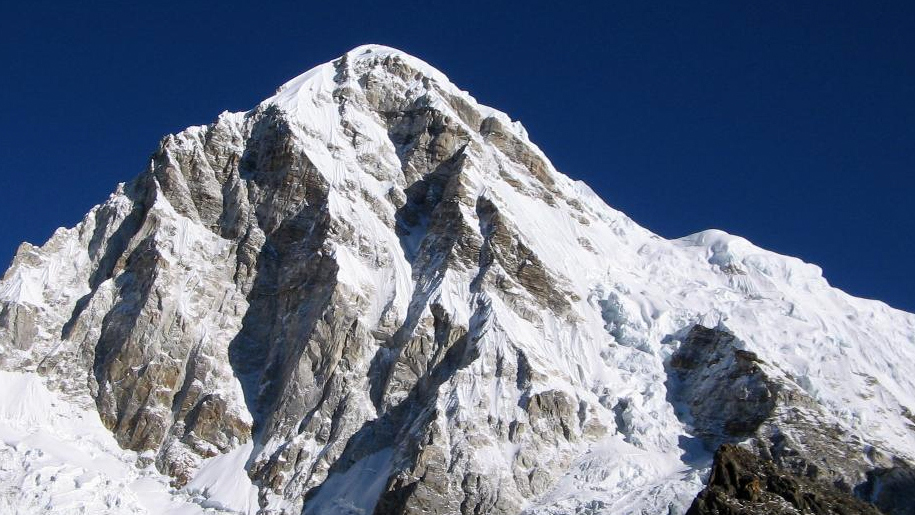
Importance Tips for the Pumori Expedition
Here are some important tips to consider when you are planning for the Pumori Expedition
- Physical Fitness: Focus on building your overall physical fitness, endurance, and strength. Engage in a comprehensive training program that includes cardiovascular exercises, strength training, and endurance activities. Pay particular attention to developing leg strength and aerobic fitness.
- Climbing Experience: Prior climbing experience is highly recommended before attempting Pumori Peak. Familiarize yourself with technical skills such as ice climbing, glacier travel, and rope handling. Experience on other high-altitude peaks will help you prepare for the challenges of Pumori.
- Acclimatization: Allow sufficient time for acclimatization to prevent altitude sickness. Plan a gradual ascent with rest days at different elevations to help your body adjust to the increasing altitude. Follow a well-designed acclimatization schedule.
- Guides and Support: Consider hiring experienced mountaineering guides that offer support services for Pumori Peak. Their knowledge, experience, and logistical support can enhance your safety and chances of success.
- Safety Equipment: Invest in high-quality mountaineering gear suitable for climbing Pumori Peak. This includes clothing, boots, gloves, helmets, crampons, ice axes, ropes, harnesses, and necessary safety gear. Ensure that your equipment is in good condition and properly fitted.
- Altitude Medication: Consult with a healthcare professional who specializes in high-altitude medicine. They can provide advice on altitude medication like Diamox to help prevent and manage altitude sickness. Follow their guidance on dosage and usage.
- Route Knowledge: Familiarize yourself with the route and terrain of Pumori Peak. Study maps, and guidebooks, and consult with experienced climbers who have previously climbed the peak. Understand the technical challenges and potential hazards of the route.
- Weather Conditions: Stay updated on weather conditions and forecasts specific to the Pumori region. Be prepared for rapidly changing weather and plan your climb accordingly. Avoid climbing during extreme weather or unfavorable conditions that could compromise safety.
- Mental Preparation: Climbing Pumori Peak requires mental resilience and determination. Prepare yourself mentally for the physical and psychological challenges you may face. Develop a positive mindset, manage stress effectively, and stay focused on your goals.
- Environmental Responsibility: Respect the mountain environment and practice responsible mountaineering. Follow Leave No Trace principles, minimize your impact on the ecosystem, and adhere to local regulations. Properly dispose of waste and avoid damaging the environment.
- Emergency Preparedness: Have contingency plans for emergencies and familiarize yourself with evacuation procedures. Carry a satellite phone or communication device for emergency situations. Stay aware of your surroundings and be prepared to respond to unexpected situations.
Climbing Pumori Peak is a significant endeavor that requires thorough planning, physical fitness, and mountaineering skills. Prioritize safety, seek proper training and guidance, and be well-prepared both physically and mentally. Enjoy the experience while respecting the mountain and fellow climbers.
Tilicho Peak (7134m)
Nestled beside the mesmerizing blue-turquoise waters of Tilicho Lake, Tilicho Peak rises majestically to an elevation of 7,134 meters. Esteemed mountaineers often categorize this peak as a technical climb, underscoring the challenges that await those who dare to ascend its slopes. From its summit, climbers are rewarded with a panoramic tapestry: the grandeur of the Annapurna massif, the imposing Dhaulagiri, the vast expanse of the Tibetan plateau, and glimpses of both the world's deepest valley, Kali Gandaki, and the serene Tilicho Lake.
While the journey to its base can traditionally be undertaken through the scenic trekking routes of the Annapurna region, those seeking a quicker approach can opt for a helicopter ride to the Khangsar Valley. This not only offers a unique aerial perspective but also significantly reduces the trekking duration. Although Tilicho Lake is a renowned trekking destination in its own right, the commanding peak that rises beside it offers an unparalleled mountaineering adventure among the seven-thousanders.
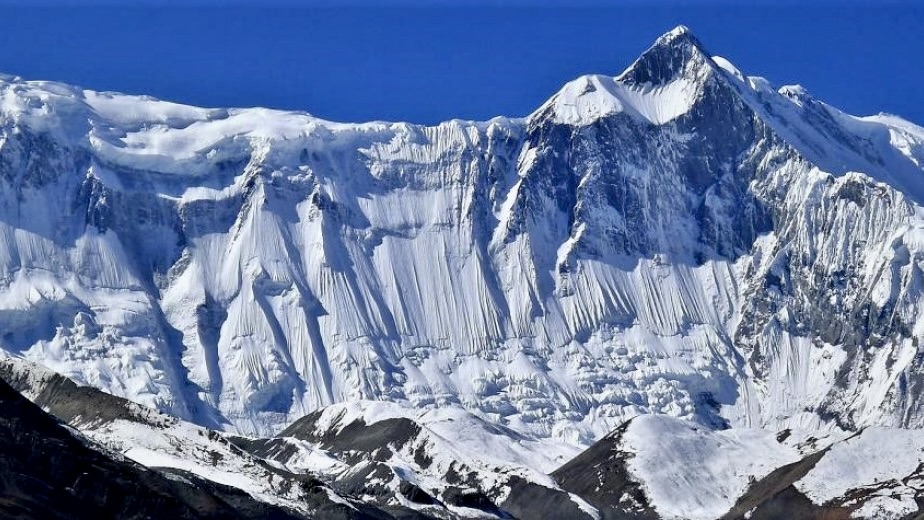
Importance Tips for the Tilicho Expedition
Here are some important tips to consider when you are planning for the Tilicho Expedition
- Physical Fitness: Focus on building your overall physical fitness, endurance, and strength. Engage in a comprehensive training program that includes cardiovascular exercises, strength training, and endurance activities. Pay particular attention to developing leg strength and aerobic fitness, as the climb to Tilicho Peak can be physically demanding.
- Climbing Experience: Prior climbing experience is highly recommended before attempting Tilicho Peak. Familiarize yourself with technical skills such as ice climbing, snow travel, and rope handling. Gain experience on other high-altitude peaks to develop the necessary mountaineering skills and familiarity with high-altitude environments.
- Acclimatization: Allow sufficient time for acclimatization to prevent altitude sickness. Plan a gradual ascent with rest days at different elevations to help your body adjust to the increasing altitude. This will increase your chances of a successful and safe climb.
- Route and Navigation: Familiarize yourself with the route to Tilicho Peak and study the maps and guidebooks. Understand the terrain, potential hazards, and the best navigation strategies. Consider joining a guided expedition or hiring an experienced local guide who knows the area well.
- Safety Equipment: Invest in high-quality mountaineering gear suitable for climbing Tilicho Peak. This includes appropriate clothing, boots, gloves, helmets, crampons, ice axes, ropes, harnesses, and necessary safety gear. Ensure that your equipment is in good condition and properly fitted before the climb.
- Weather Conditions: Stay updated on the weather conditions in the Tilicho region. Check weather forecasts and plan your climb accordingly. Be prepared for rapidly changing weather, including snowfall and high winds. Avoid climbing during extreme weather conditions that could compromise safety.
- Altitude Medication: Consult with a healthcare professional who specializes in high-altitude medicine. They can provide advice on altitude medication such as Diamox to help prevent and manage altitude sickness. Follow their guidance on dosage and usage.
- Mental Preparation: Climbing Tilicho Peak requires mental resilience and determination. Prepare yourself mentally for the physical and psychological challenges you may face. Develop a positive mindset, manage stress effectively, and stay focused on your goals.
- Environmental Responsibility: Respect the mountain environment and practice responsible mountaineering. Follow Leave No Trace principles, minimize your impact on the ecosystem, and adhere to local regulations. Properly dispose of waste and avoid damaging the environment.
- Emergency Preparedness: Have contingency plans for emergencies and familiarize yourself with evacuation procedures. Carry a satellite phone or communication device for emergency situations. Understand how to use emergency equipment such as a GPS device or personal locator beacon.
Climbing Tilicho Peak is a challenging endeavor that requires careful planning, physical fitness, and mountaineering skills. Prioritize safety, seek proper training and guidance, and be well-prepared both physically and mentally. Enjoy the experience while respecting the mountain and fellow climbers.
Baruntse Peak (7129m)
Baruntse Peak, soaring to 7,129 meters, is a symmetrical marvel cradled between the Barun Glacier to the north and the combined embrace of the Imja Tse and Hunku Glaciers to its south and east. Despite its formidable height, Baruntse is relatively accessible, boasting a high success rate among climbers aiming for its summit. Its geographical prominence is further enhanced as it stands in proximity to some of the world's titan peaks, including Mt. Everest, Lhotse, Makalu, and Cho Oyu.
 climbing.jpg)
The Baruntse expedition uniquely spans two weeks, with climbers given the chance to scale Mera Peak first, serving both as acclimatization and an additional achievement. The peak's legacy was inaugurated by Colin Todd and Geoff Harrow from a New Zealand expedition in 1954, marking its first successful ascent. While Baruntse may not be the most technically challenging of mountains, it demands significant physical stamina, particularly along its extended approach to the summit.
Important Tips for the Baruntse Expedition
Here are some important tips to consider when you are planning for the Baruntse Expedition
- Climbing Experience: Baruntse is a technically demanding peak and requires prior high-altitude climbing experience. Climbers attempting Baruntse should have experience with ice and rock climbing, as well as glacier travel and crevasse rescue skills. Previous experience on other 6,000-meter peaks is highly recommended.
- Physical Fitness: Being in excellent physical condition is crucial for a successful Baruntse expedition. Engage in a rigorous training regimen several months before the climb, focusing on cardiovascular fitness, strength training, and endurance exercises. Climbing at high altitudes requires significant stamina.
- Team and Guides: Consider joining a guided expedition led by experienced and certified mountain guides. A reputable guiding company can provide essential support, logistics, and safety measures during the climb, increasing your chances of success.
- Gear and Equipment: Invest in high-quality mountaineering gear suitable for extreme cold and high-altitude conditions. This includes technical climbing gear, mountaineering boots, crampons, ice axes, harnesses, ropes, helmets, and high-altitude clothing. Ensure that your gear is in excellent condition and properly fitted.
- Acclimatization: Proper acclimatization is vital for any high-altitude expedition. Plan a gradual ascent with ample rest days to allow your body to adapt to the thin air. Climbing nearby peaks or spending time at intermediate base camps can aid in acclimatization.
- Weather and Climbing Season: Choose the climbing season carefully. The best time for Baruntse expeditions is generally during the pre-monsoon (spring) and post-monsoon (autumn) seasons when the weather is relatively stable. However, even during these seasons, weather conditions can change rapidly in the mountains.
- Route and Navigation: Familiarize yourself with the chosen route and study maps and guidebooks. Understand the potential hazards, avalanche-prone areas, and the best navigation strategies. Climbing with a knowledgeable guide can help ensure you follow the correct route.
- High-Altitude Medicine: Consult with a healthcare professional experienced in high-altitude medicine. Discuss medications such as Diamox to aid acclimatization and potential treatments for altitude-related illnesses. Carry a well-stocked first aid kit and know how to use it.
- Communication and Emergency Plan: Have reliable communication equipment such as satellite phones or radios to stay in contact with your team and base camp. Establish an emergency plan in case of unforeseen circumstances and have a clear evacuation strategy in place.
- Environmental Responsibility: Practice responsible and ethical mountaineering. Follow Leave No Trace principles, minimize your impact on the environment, and respect local customs and traditions.
Climbing Baruntse Peak is a challenging and rewarding adventure. Thorough preparation, adequate training, and experienced guidance are crucial for your safety and success. Be mentally prepared for the difficulties and uncertainties that high-altitude climbing presents. Enjoy the breathtaking beauty of the Himalayas while ensuring you prioritize safety and responsible mountaineering practices.
Mardi Himal (5587m)
Mardi Himal, celebrated for its captivating trek through dense forests and the allure of its high and low camps, stands as a beacon for trekkers and climbers in Nepal. Ideal for novices venturing into Himalayan ascents, this peak is nestled within the Annapurna Conservation Area, reaching an elevation of 5,587 meters. It proudly shares its horizon with the iconic Fishtail Mountain, known locally as Mt. Macchhapuchre.
Uniquely, Mardi Himal welcomes aspiring climbers with open arms, free of charge. It stands as an excellent introductory climb for those looking to hone their skills for more challenging ascents. The inaugural conquest of this peak dates back to 1961, credited to Jimmy Roberts. The journey towards its summit meanders through lush forests, unveiling breathtaking panoramas of the Annapurna range. Beyond its natural splendor, Mardi Himal introduces trekkers to the rich tapestry of local ethnic cultures and traditions, making the expedition as enlightening as it is exhilarating.
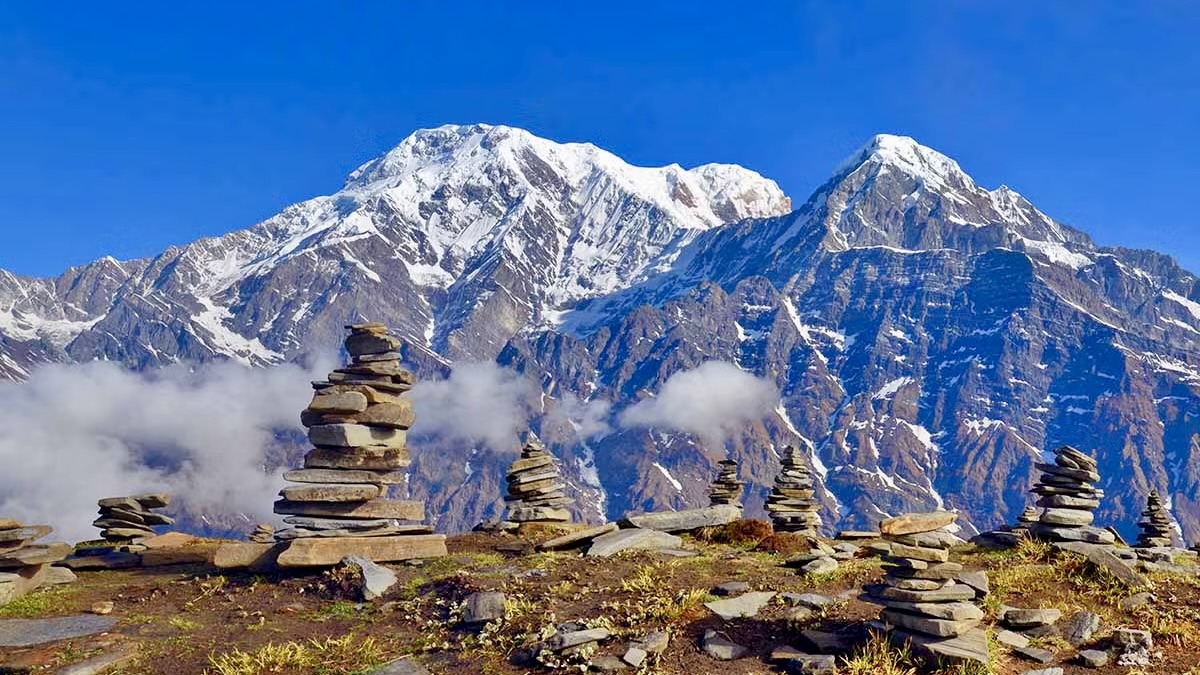
Importance Tips for the Mardi Himal Expedition
Here are some important tips to consider when you are planning for the Mardi Himal Expedition
- Physical Fitness: Focus on building your overall physical fitness and endurance. Engage in a training program that includes cardiovascular exercises, strength training, and hiking to prepare your body for the demands of the climb. Pay attention to building leg strength and stamina.
- Altitude Experience: While Mardi Himal Peak is not as high as some of the other peaks in the region, it is still important to have some experience with high-altitude trekking. Prior experience at elevations above 4,000 meters will help you acclimatize and adjust to the altitude during the climb.
- Navigation Skills: Familiarize yourself with navigation techniques and maps for the Mardi Himal route. The trail can be less defined in certain sections, so having good navigation skills will be beneficial. Consider hiring a local guide who is familiar with the area if you are not confident in your navigation abilities.
- Gear and Equipment: Invest in proper mountaineering gear suitable for climbing Mardi Himal Peak. This includes appropriate clothing, boots, gloves, trekking poles, a backpack, a sleeping bag, a tent, and other necessary equipment. Make sure your gear is lightweight, durable, and suitable for the expected weather conditions.
- Permits and Regulations: Obtain the necessary permits for climbing Mardi Himal Peak. Check the current regulations and requirements set by the local authorities. Respect the rules and guidelines in place to preserve the natural environment and ensure a safe climbing experience.
- Weather Conditions: Stay updated on the weather conditions in the Mardi Himal region. Check weather forecasts regularly and plan your climb accordingly. Be prepared for changes in weather and pack appropriate clothing and gear to handle different conditions.
- Safety and Emergency Preparedness: Carry a first aid kit and familiarize yourself with basic first aid procedures. Have a communication device, such as a mobile phone or satellite phone, to contact emergency services if needed. Inform someone about your climbing plans and expected return date.
- Leave No Trace: Practice responsible and sustainable trekking by following the principles of Leave No Trace. Minimize your impact on the environment, pack out all your trash, and respect the local culture and customs.
Climbing Mardi Himal is a rewarding adventure. Ensure you are adequately prepared physically, mentally, and logistically. Respect the environment, prioritize safety, and have a memorable climb.
Mera Peak (6476m)
Rising majestically to an elevation of 6,476 meters, Mera Peak holds the distinction of being the highest trekking peak in Nepal. Its summit offers unparalleled panoramic views, showcasing a breathtaking array of Himalayan giants over 8,000 meters, including Everest, Lhotse, Cho Oyu, Makalu, and Kanchenjunga.
While Mera Peak's ascent doesn't demand advanced technical prowess, it certainly requires climbers to be in top physical shape, given its formidable altitude for a trekking peak. Those with a solid background in trekking or prior climbing experiences stand in good stead. The journey to its apex unfolds a series of nature's marvels – from ethereal frozen lakes to imposing hanging glaciers – presenting sights that remain etched in the memory of those fortunate enough to witness them.
 climbing.jpg)
Importance tips for Mera Peak
Here are some important tips to consider when you are planning for the Mera Peak Expedition
- Physical Fitness: Mera Peak requires a good level of physical fitness and endurance. Engage in a comprehensive training program that includes cardiovascular exercises, strength training, and hiking to prepare your body for the demands of the climb. Focus on building leg strength, aerobic fitness, and stamina.
- Altitude Acclimatization: Mera Peak reaches an altitude of 6,476 meters (21,247 feet), so proper acclimatization is crucial. Plan a gradual ascent with rest days at various elevations to allow your body to adjust to the increasing altitude. Follow a well-designed acclimatization schedule and listen to your body.
- Climbing Experience: Prior climbing experience is highly recommended before attempting Mera Peak. Familiarize yourself with mountaineering skills such as rope handling, ice climbing, and glacier travel. Experience on other high-altitude peaks will help you understand the challenges and techniques required for Mera Peak.
- Guides and Support: Consider hiring an experienced climbing guide that offers support services for Mera Peak. Their knowledge, experience, and logistical support can enhance your safety and chances of success. They can provide guidance on the route, safety measures, and handling technical sections.
- Gear and Equipment: Invest in high-quality mountaineering gear suitable for climbing Mera Peak. This includes clothing suitable for cold and high-altitude conditions, sturdy mountaineering boots, crampons, ice axes, harnesses, ropes, helmets, and other necessary safety gear. Ensure that your gear is in good condition and properly fitted.
- Weather Conditions: Stay updated on weather conditions and forecasts specific to the Mera Peak region. Be prepared for rapidly changing weather and extreme cold temperatures. Check weather updates regularly and plan your climb accordingly. Avoid climbing during adverse weather conditions that could compromise safety.
- High-Altitude Medication: Consult with a healthcare professional who specializes in high-altitude medicine. They can provide advice on altitude medication such as Diamox to help prevent and manage altitude sickness. Follow their guidance on dosage and usage.
- Safety and Emergency Preparedness: Carry a first aid kit and be familiar with basic first aid procedures. Have a communication device, such as a satellite phone or a radio, to contact emergency services if needed. Understand and be prepared for potential hazards such as crevasses, avalanches, and extreme weather.
- Environmental Responsibility: Respect the mountain environment and practice responsible mountaineering. Follow Leave No Trace principles, minimize your impact on the ecosystem, and adhere to local regulations. Properly dispose of waste and avoid damaging the environment.
- Mental Preparedness: Climbing Mera Peak requires mental resilience and determination. Prepare yourself mentally for the physical and psychological challenges you may face. Develop a positive mindset, manage stress effectively, and stay focused on your goals.
Climbing Mera Peak is a significant undertaking that requires thorough planning, physical fitness, and mountaineering skills. Prioritize safety, seek proper training and guidance, and be well-prepared both physically and mentally.
Chulu West Peak (6584m)
Chulu West Peak stands as a renowned gem among trekking peaks, cherished by both novice and seasoned climbers. In terms of technical demand, it offers a relatively approachable ascent, although it necessitates a formidable level of physical strength to conquer its summit. Perched at an astonishing elevation of 6,584 meters, this climb promises an exhilarating experience, gifting climbers with breathtaking vistas of the Annapurna and Manang Himalayas.
The journey to Chulu West unfolds along the famed Annapurna Circuit Trekking Trail, a passage adorned with untamed and diverse flora and fauna, carefully conserved within protected parks. The acclimatization process en route includes a visit to Thorung La Pass (5,416m), a trekking destination in its own right. This high-altitude trail further extends to the Kali Gandaki valley, the world's deepest gorge, surrounded by peaks that rival even the mighty Mt. Everest. The dedication and months of strenuous preparation culminate in the ascent, a rewarding experience that usually spans 60 days or more, contingent on weather conditions and the climber's adaptability to these lofty elevations, where every individual's response can vary.
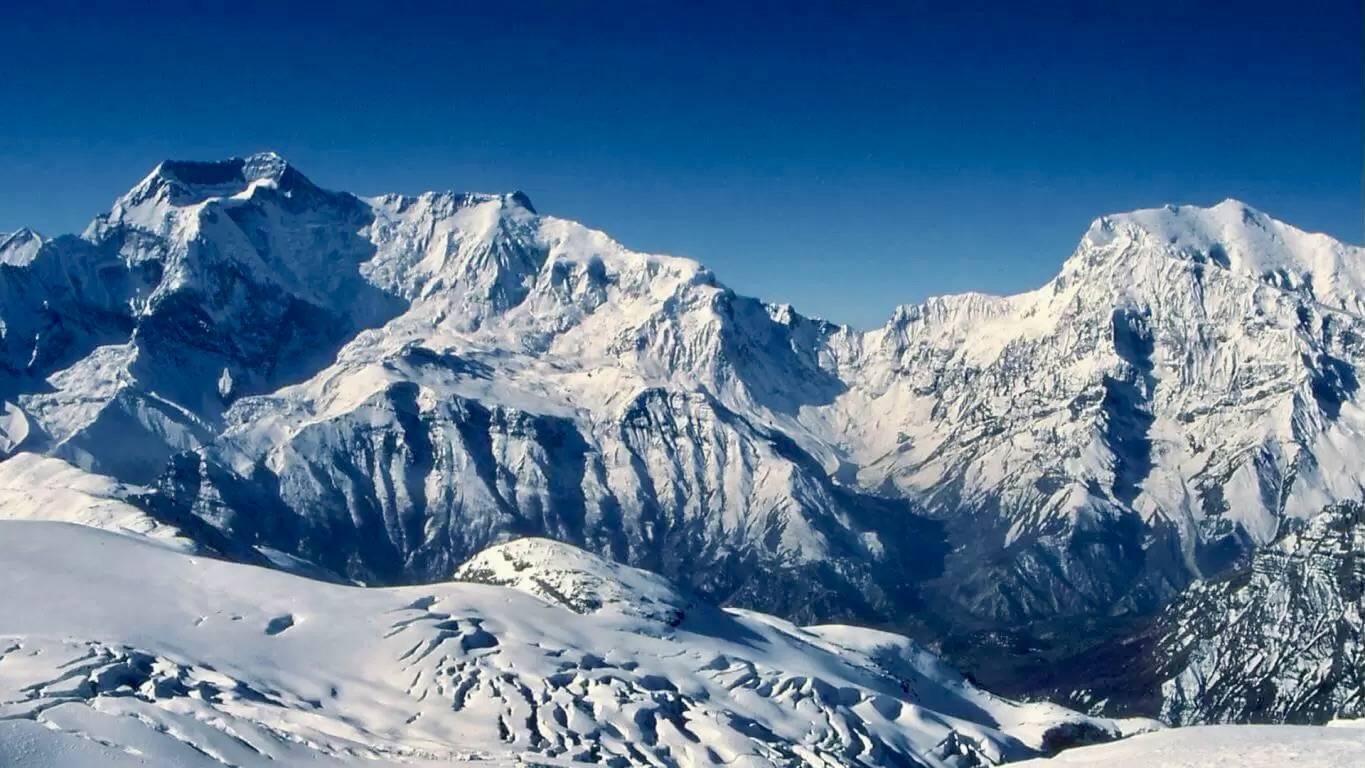
Importance Tips for Chulu West Peak Expedition
Here are some important tips to consider when you are planning for the Chulu West Peak Expedition
- Physical Fitness: Chulu West Peak requires a good level of physical fitness and endurance. Engage in a comprehensive training program that includes cardiovascular exercises, strength training, and hiking to prepare your body for the demands of the climb. Focus on building leg strength, aerobic fitness, and stamina.
- Altitude Acclimatization: Proper acclimatization is crucial for climbing Chulu West Peak. Plan a gradual ascent with rest days at different elevations to allow your body to adjust to the increasing altitude. Follow a well-designed acclimatization schedule and listen to your body. This will help minimize the risk of altitude sickness.
- Climbing Experience: Prior climbing experience is highly recommended before attempting Chulu West Peak. Familiarize yourself with mountaineering skills such as rope handling, glacier travel, and ice climbing. Gain experience on other high-altitude peaks to develop the necessary mountaineering skills and familiarity with high-altitude environments.
- Guides and Support: Consider hiring an experienced climbing guide that offers support services for Chulu West Peak. Their knowledge, experience, and logistical support can enhance your safety and chances of success. They can provide guidance on the route, safety measures, and handling technical sections.
- Gear and Equipment: Invest in high-quality mountaineering gear suitable for climbing Chulu West Peak. This includes clothing suitable for cold and high-altitude conditions, sturdy mountaineering boots, crampons, ice axes, harnesses, ropes, helmets, and other necessary safety gear. Ensure that your gear is in good condition and properly fitted.
- Route and Navigation: Familiarize yourself with the route to Chulu West Peak and study the maps and guidebooks. Understand the terrain, potential hazards, and the best navigation strategies. Consider joining a guided expedition or hiring an experienced local guide who knows the area well.
- Weather Conditions: Stay updated on the weather conditions in the Chulu West Peak region. Check weather forecasts and plan your climb accordingly. Be prepared for rapidly changing weather, including snowfall and high winds. Avoid climbing during extreme weather conditions that could compromise safety.
- High-Altitude Medication: Consult with a healthcare professional who specializes in high-altitude medicine. They can provide advice on altitude medication such as Diamox to help prevent and manage altitude sickness. Follow their guidance on dosage and usage.
- Safety and Emergency Preparedness: Carry a first aid kit and be familiar with basic first aid procedures. Have a communication device, such as a satellite phone or a radio, to contact emergency services if needed. Understand and be prepared for potential hazards such as crevasses, avalanches, and extreme weather.
- Environmental Responsibility: Respect the mountain environment and practice responsible mountaineering. Follow Leave No Trace principles, minimize your impact on the ecosystem, and adhere to local regulations. Properly dispose of waste and avoid damaging the environment.
- Climbing Chulu West Peak is a challenging and rewarding adventure. Thorough planning, physical fitness, and mountaineering skills are essential. Prioritize safety, seek proper training and guidance, and be well-prepared both physically and mentally.
Best Time/Season for Climbing and Expedition in Nepal
Autumn and Season in Nepal is considered the best season for climbing because the weather during this period of time is extremely calm and peaceful unlike in summer or monsoon season. The temperature in the mountains remains adequate for the Himalayan region which may be cold enough for normal people but it is the best of temperature we can get in the whole time of year.
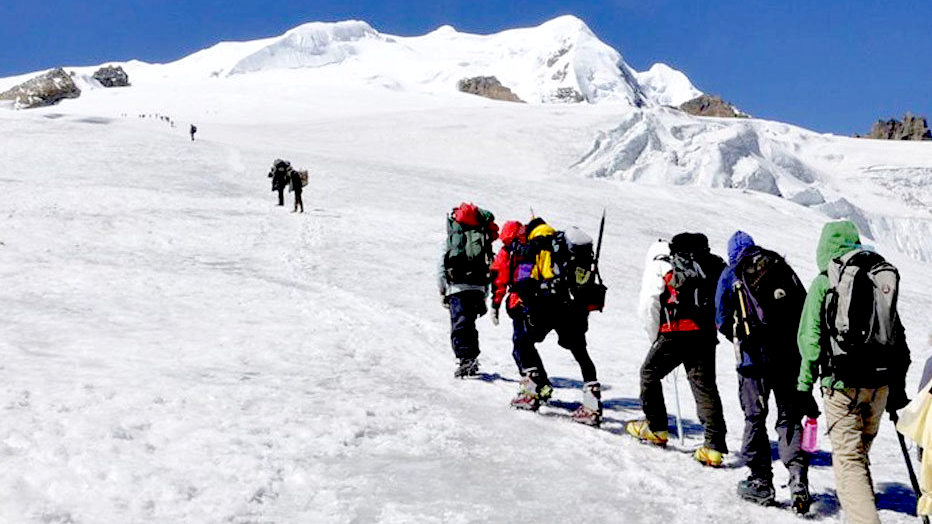
However, the best period for climbing some of the peaks may differ from normal peaks because of the change in physical geography and terrain of that specific peak. The time for climbing would jointly be fixed by you and your professional guide leading you climbing.
Spring Season (March to May)
- Weather: Mild temperatures, clear skies, and relatively low precipitation.
- Highlights: Blooming rhododendron forests, vibrant landscapes, and excellent visibility for climbing and trekking.
- Popular Activities: Everest Base Camp trek, Annapurna Circuit trek, Manaslu trek, peak climbing expeditions, and all the adventure sports activities (wildlife, water, etc).
Summer/Monsoon Season (June to August)
- Weather: High temperatures, increased humidity, and heavy rainfall due to the monsoon season.
- Considerations: Trails can be muddy, slippery, and prone to landslides. Some areas may experience leeches and increased mosquito activity.
- Popular Activities: Restricted to lower elevation treks, such as Langtang Valley trek, Upper Mustang trek and city tours.
Autumn Season (September to November)
- Weather: Clear skies, mild temperatures, and minimal rainfall.
- Highlights: Stunning mountain views, pleasant weather, and stable climbing conditions.
- Popular Activities: Trekking in most of the region, all the adventure sports activities, and peak climbing expeditions.
Winter Season (December to February)
- Weather: Cold temperatures, especially at higher altitudes. Clear skies with occasional snowfall.
- Considerations: Higher elevation trails may have heavy snow, and some passes may be closed. Proper gear and experience are required for high-altitude trekking.
- Popular Activities: Lower elevation treks like the Ghorepani Poon Hill trek, Golden Triangle tour, and various other city tours.
It's important to note that these are general characteristics of each season, and weather patterns can vary. It's always advisable to check the specific conditions and consult with local authorities or experienced trekkers/climbers before planning your trip.
Frequently asked questions (FAQs) for the 9 Best climbing in Nepal
Q: What are the 9 best climbing peaks in Nepal?
A: The 9 best climbing peaks in Nepal are Everest (8,848.86m), Lhotse (8,516m), Manasalu (8,163m), Pumori Peak (7,161m), Tilicho Peak (7,134m), Baruntse Peak (7,129m), Mardi Himal (5,587m), Mera Peak (6,476m), and Chulu West Peak (6,584m).
Q: When is the best time to climb these peaks in Nepal?
A: The best climbing seasons in Nepal are typically during the pre-monsoon (spring) from April to May and post-monsoon (autumn) from late September to November. These months offer the most stable weather conditions.
Q: Do I need a permit to climb these peaks in Nepal?
A: Yes, climbers require permits to climb these peaks in Nepal. The specific permits and fees vary depending on the mountain and the climbing season. You may also need trekking permits in some regions.
Q: Are these peaks suitable for novice climbers?
A. Some of these peaks, like Mardi Himal and Mera Peak, are more suitable for climbers with basic mountaineering skills. However, peaks like Everest and Lhotse require extensive high-altitude mountaineering experience.
Q: What is the difficulty level of climbing Everest compared to the other peaks?
A. Climbing Everest is considered the most challenging due to its extreme altitude and technical difficulties. It's often referred to as the ultimate mountaineering challenge. Other peaks vary in difficulty, with some being more accessible to less experienced climbers.
Q. Can I climb these peaks independently, or do I need to join an expedition team?
A. While some peaks can be climbed independently, it's highly recommended, especially for the more challenging mountains, to join an experienced expedition team or a climbing guide for safety and logistical support.
Q. What gear and equipment do I need for climbing these peaks?
A. The required gear and equipment depend on the specific peak and season. Generally, you'll need high-altitude mountaineering gear, including clothing suitable for extreme cold, climbing equipment, and a well-equipped backpack.
Q: What is the cost of climbing these peaks in Nepal?
A. The cost varies widely depending on the peak, the expedition company, and the services included. Climbing Everest, for example, can cost tens of thousands of dollars, while less challenging peaks are more affordable.
Q. What environmental responsibilities should climbers be aware of?
A. Climbers in Nepal are expected to follow Leave No Trace principles, dispose of waste properly, and respect local customs and traditions. Conservation and environmental awareness are essential.
Similarly other 8000-meter Mountains for Climbing and Expedition in Nepal
Makalu Expedition (8,463m)
Manaslu Expedition (8,163 m)
Kanchenjunga Expedition (8,586 m)
Lhotse Expedition (8,516 m)
Mt. Everest Expedition (8848.86 m)
Dhaulagiri Expedition (8,167 m)
7000-meter peaks for Climbing and Expedition in Nepal
Gangapurna Expedition (7,455 m)
Pumori Expedition (7,145 m)
Tilicho Peak Expedition (7,134 m)
Annapurna South Expedition (7,219 m)
6000-meter peaks for Climbing and Expedition in Nepal
Mt Ama Dablam Expedition (6,812 m)
Island Peak Expedition (6,160 m)
Mera Peak Climbing (6,476 m)
Chulu West Peak Climbing (6,419 m)
Pisang Peak Climbing (6,091 m)
Singu Chuli Peak Climbing (6,501 m)
If you need any further information, please contact us by email: at [email protected], Phone: at +977- 985 100 5129 (WhatsApp)
#Tags
Tripadvisor
5.0910 reviewsGoogle
4.8110 reviewsFacebook
4.1 recommend44 ReviewsTrustpilot
4.1 Great(5 reviews)- Trusted by50K plus traveller




